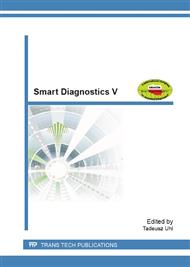[1]
I.K. Senchenkov, V.G. Karnaukhov, Thermomechanical behavior of nonlinearly viscoelastic materials under harmonic loading, Int. Appl. Mech. 37 (2001) 1400-1432.
Google Scholar
[2]
B.J. Adzima, C.J. Kloxin, C.N. Bowman, Externally triggered healing of a thermoreversible covalent network via self-limited hysteresis heating, Adv. Mater. 22 (2010) 2784-2787.
DOI: 10.1002/adma.200904138
Google Scholar
[3]
C. Roos, C.E. Bakis, Multi-physics design and optimization of flexible matrix composite driveshafts, Compos. Struct. 93 (2011) 2231-2240.
DOI: 10.1016/j.compstruct.2011.03.011
Google Scholar
[4]
Z. Fan, S. Kang, Numerical simulations of the aerodynamics of horizontal axis wind turbines, Inaugural US-EU-China Thermophysics Conference – Renewable Energy 2009.
DOI: 10.1115/1.802908.paper16
Google Scholar
[5]
A. Ramkumar, K. Kannan, R. Gnanamoorthy, Experimental and theoretical investigation of a polymer subjected to cyclic loading conditions, Int. J. Eng. Sci. 48 (2010) 101-110.
DOI: 10.1016/j.ijengsci.2009.07.002
Google Scholar
[6]
A.N. Boyarov, Mechanism of formation and protection from spontaneous ignition of the pyrophoric sedimentations in vertical reservoirs (in Russian), PhD Thesis, Ufa 2010.
Google Scholar
[7]
A. Faghri, Z. Guo, Challenges and opportunities of thermal management issues related to fuel cell technology and modeling, Int. J. Heat Mass Trans. 48 (2005) 3891-3920.
DOI: 10.1016/j.ijheatmasstransfer.2005.04.014
Google Scholar
[8]
J. de Cazenove, D.A. Rade, A.M.G. de Lima, C.A. Araújo, A numerical and experimental investigation on self-heating effects in viscoelastic dampers, Mech. Syst. Signal Pr. 27 (2012) 433-445.
DOI: 10.1016/j.ymssp.2011.05.004
Google Scholar
[9]
C.M. Sonsino, E. Moosbrugger, Fatigue design of highly loaded short-glass-fibre reinforced polyamide parts in engine compartments, Int. J. Fatigue 30 (2008) 1279-1288.
DOI: 10.1016/j.ijfatigue.2007.08.017
Google Scholar
[10]
S.B. Ratner, V.I. Korobov, Self-heating of plastics during cyclic deformation, Mekh. Polim. 1 (1965) 93-100.
Google Scholar
[11]
P.P. Oldyrev, Self-heating and failure of plastics under cyclic loading, Mekh. Polim. 3 (1967) 483-492.
Google Scholar
[12]
M.N. Riddell, G.P. Koo, J.L. O'Toole, Fatigue mechanisms of thermoplastics, Polym. Eng. Sci. 10 (1966) 363-368.
DOI: 10.1002/pen.760060414
Google Scholar
[13]
I. Constable, J.G. Williams, D.J. Burns, Fatigue and thermal softening of thermoplastics, J. Mech. Sci. Technol. 12 (1970) 20-29.
Google Scholar
[14]
W. Hufenbach, U. Hoffman, Werkstoffdämpfung Anisotroper Polymerer Faserverbunde. Teil 2, Ingenieur-Werkstoffe 3 (1991) 50-52.
Google Scholar
[15]
D. Rittel, Experimental investigation of transient thermoelastic effects in dynamic fracture, International J. Solids Struct. 35 (1998) 2959-2973.
DOI: 10.1016/s0020-7683(97)00352-1
Google Scholar
[16]
D. Rittel, An investigation of the heat generated during cyclic loading of two glassy polymers. Part I: Experimental, Mech. Mater. 32 (2000) 131-147.
DOI: 10.1016/s0167-6636(99)00051-4
Google Scholar
[17]
A. Katunin, M. Fidali, Self-heating of polymeric laminated composite plates under the resonant vibrations: theoretical and experimental study, Polym. Compos. 33 (2012) 138-146.
DOI: 10.1002/pc.22134
Google Scholar
[18]
A. Katunin, Critical self-heating temperature during fatigue of polymeric composites under cyclic loading, Composites Theory Pract. 12 (2012) 72-76.
Google Scholar
[19]
A.D. Kovalenko, V.G. Karnaukhov, On heat generation in viscoelastic bodies under periodic action, Prikl. Mekh. 5 (1969) 28-35.
Google Scholar
[20]
A. Katunin, Self-heating effect in laminate plates during harmonic forced loading, Sci. Probl. Mach. Oper. Maint. 44 (2009) 73-84.
Google Scholar
[21]
A. Katunin, Analytical model of the self-heating effect in polymeric laminated rectangular plates during bending harmonic loading, Ekspl. Niezawodn. 48 (2010) 91-101.
Google Scholar
[22]
A. Katunin, Stationary self-heating of the circular and annular composite plates hinged on the boundary under axisymmetric cyclic loading, Adv. Compos. Lett. 20 (2011) 121-125.
DOI: 10.1177/096369351102000501
Google Scholar
[23]
A. Katunin, W. Hufenbach, P. Kostka, K. Holeczek, Frequency dependence of the self-heating effect in polymer-based composites, J. Achiev. Mater. Manuf. Eng. 41 (2010) 9-15.
Google Scholar
[24]
A. Katunin, A. Gnatowski, Influence of heating rate on evolution of dynamic properties of polymeric laminates, Plast. Rubber Compos. 41 (2012) 233-239.
DOI: 10.1179/1743289811y.0000000037
Google Scholar
[25]
A. Katunin, Evaluation of fatigue durability of polymeric laminates in viscoelastic state considering thermal phenomena, PhD Thesis, Gliwice 2012.
Google Scholar
[26]
M. Poncelet, C. Doudard, S. Calloch, B. Weber, F. Hild, Probabilistic multiscale models and measurements of self-heating under multiaxial high cycle fatigue, J. Mech. Phys. Solids 58 (2010) 578-593.
DOI: 10.1016/j.jmps.2010.01.003
Google Scholar


